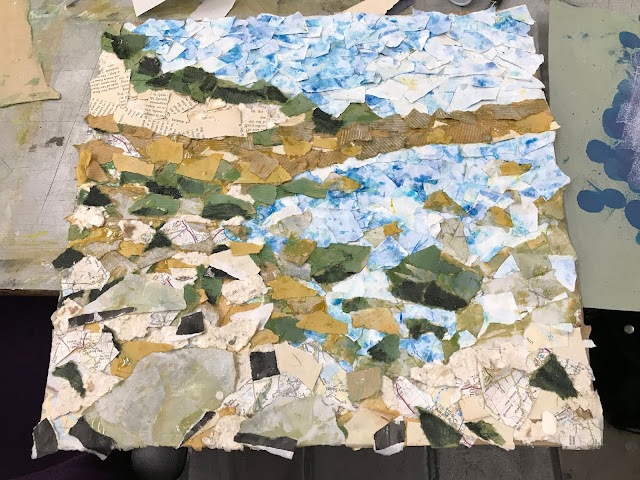Wednesday, 22 January 2020
Artists Who Use Print
Many artists use lino cuts as a way to explore different media. The sharp lines can be very expressive. Book illustrators use the technique to create simple single or two colour images particularly for children's books.
Sunday, 12 January 2020
Artists Who Use Textured Surfaces and Collage
Painting or drawing onto a textured surface is as old as painting itself. Ancient people used the natural contours of cave walls to help them recreate the animals that were so vital to their survival.
The decoration of tombs, temples and churches required artists to paint onto plaster and wood.
Contemporary artists continue to use the texture of a surface to help them convey added depth to their work.
Valery Koshlyakov
Valery depicts grand formal architecture on a monumental scale. But his use of roughly torn cardboard boxes, dripping paint and fast vigorous mark making plants these structures firmly into the modern frenetic through-away world.
Anselm Kiefer
Born just after the Second World War, Anselm's work addresses the issues faced by the post-war generation of Germans . The highly textured mixed media surfaces of his paintings shows an emotional but uncompromising and brave response to a dark legacy.
John Piper used found papers and prepared textured surfaces in his seascapes of the 1930's.
Illustrators also use prepared surfaces and collage. Two notable examples are Mark Hearld and Eric Carle.
The decoration of tombs, temples and churches required artists to paint onto plaster and wood.
Contemporary artists continue to use the texture of a surface to help them convey added depth to their work.
Valery Koshlyakov
Valery depicts grand formal architecture on a monumental scale. But his use of roughly torn cardboard boxes, dripping paint and fast vigorous mark making plants these structures firmly into the modern frenetic through-away world.
Anselm Kiefer
Born just after the Second World War, Anselm's work addresses the issues faced by the post-war generation of Germans . The highly textured mixed media surfaces of his paintings shows an emotional but uncompromising and brave response to a dark legacy.
John Piper used found papers and prepared textured surfaces in his seascapes of the 1930's.
Illustrators also use prepared surfaces and collage. Two notable examples are Mark Hearld and Eric Carle.
Saturday, 11 January 2020
Wednesday, 8 January 2020
Mark Making
Mark making is a term used to describe the lines, patterns and textures that can be created using different art materials in different ways. A whole range of descriptive marks can be made using a simple 2B pencil by moving it quickly, slowly, heavily or softly across the surface of the paper.
Some of the best examples of mark making can be seen in the drawings of sculptors. Because of their close relationship with the tactile nature of objects - surfaces, textures and forms - their drawings use marks in the most descriptive and sensitive ways.
The drawings of Henry Moore epitomise this concept. Whether it be his war time drawings of underground shelters and miners, preliminary sketches for sculptures or his beloved sheep, his use of simple media such as inks, wax crayon, charcoal and chalks shows his deep understanding of form and texture.
Peter Randall-Page produces large sculptures based on seed forms. His drawings explore the forms and shapes in intense detail.
Sarah Sze uses objects that would normally end up in the recycling bin to create installations that fill whole rooms. Her drawings reflect the shapes and patterns, not only of the objects within the sculpture, but of the spaces in between.
Some of the best examples of mark making can be seen in the drawings of sculptors. Because of their close relationship with the tactile nature of objects - surfaces, textures and forms - their drawings use marks in the most descriptive and sensitive ways.
The drawings of Henry Moore epitomise this concept. Whether it be his war time drawings of underground shelters and miners, preliminary sketches for sculptures or his beloved sheep, his use of simple media such as inks, wax crayon, charcoal and chalks shows his deep understanding of form and texture.
Peter Randall-Page produces large sculptures based on seed forms. His drawings explore the forms and shapes in intense detail.
Sarah Sze uses objects that would normally end up in the recycling bin to create installations that fill whole rooms. Her drawings reflect the shapes and patterns, not only of the objects within the sculpture, but of the spaces in between.
Subscribe to:
Posts (Atom)













































